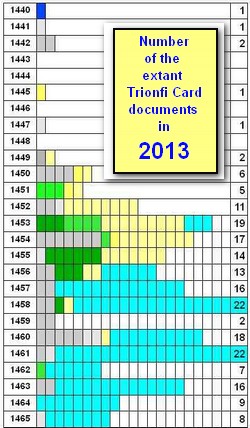Expensive decks, 20 Soldi and above
composed by Lothar Teikemeier, last updated 06.12.2012,
The cheapest Trionfi deck in Ferrara (1442, sold by Marchione Burdochi, L. 0. XII. III) would have been taken c. 20 Soldi in Florence, as the Soldi in the Ferrarese Lira Marchesana currency had an higher value than the Soldi of Florence, at least during 15th century.
The usual cheapest price for Trionfi decks in Florence had been 9 Soldi (Florentine currency), only in 2 cases the price were a little lower.
FlorenceI collected in the momentary research situation (November 2012) all "expensive decks" (defined as valued equal to or higher than 20 soldi) in Florence based on the lists of the silk dealers and of the Puri and Lapini family: It are not very much.Lapini family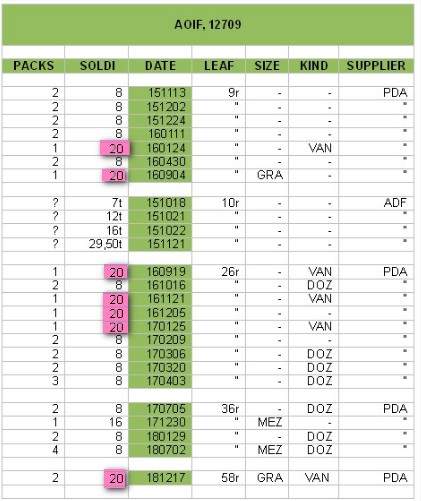 Source: Lapini article The Lapini family acquires between 1416-01-24 and 1418-12-17 at 7 different dates totally 8 decks, each for 20 Soldi, all from the artist Piero di Antonio. Only in one case they buy more than 1 deck for this price, the family likey fears to invest too much money in the insecure business of luxury decks. The highest price for Trionfi decks (1453-55) at the Lapini store is 16.5 Soldi, the lowest price 14 Soldi. Totally 12 Trionfi decks are traded in 5 different sales. Puri family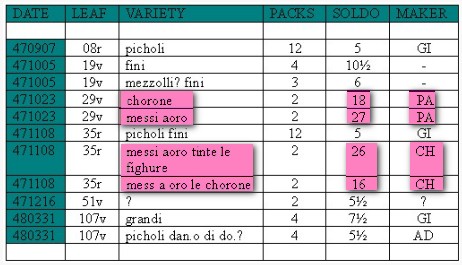 Source: Puri fanily article The Puri family has in their sale lists in 1447 twice decks higher than 20 Soldi (2 decks for 27 Soldi, 2 decks for 26 Soldi). Both deck types are likely painted by Paparello, and likely both fall in the category "chorone", which only appears at the Puri family sales lists (1447) and as a game name "corone" in Massa Marittima near Siena (1445). Two other sales (2 decks for 18 Soldi, 2 decks for 16 Soldi) also belong to the categories "Chorone" and "likey painted by Paparello". That, what we know of the Puri family, doesn't contain any note about Trionfi decks. Silk dealer Sales list Source: Silk dealer sales At 1440-02-06 a single deck is sold to "Gerardo di Pagholo e comp. Setaiuoli" (so another silk dealer) for 33 Soldi with the qualities "Grandi" and "Dorati". The producer of the deck is not known. The date is a half year earlier than the oldest Trioni deck note from 1440-09-16.  Source: Silk dealer sales At 1445-01-23 a single Trionfi deck is sold for 25 Soldi to "Martino di Giovanni di Pellegrino da Bergamo merciai". The producer of the deck is not known, but there's a sort of suspicion, that it might have been Antonio di Dino. Totally the silk dealer have 4 activities with Trionfi cards in the sale account books: This relates to totally 11 Trionfi decks, for which the silk dealer get c. 130 Soldi. Silk dealer acquire list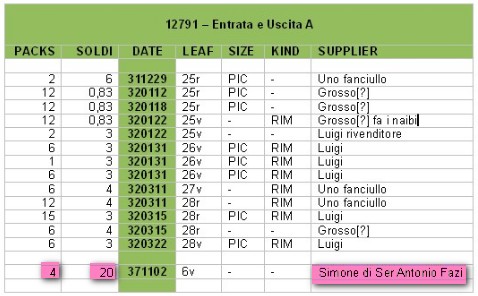 Source: Silk dealer acquire lists Simone di Ser Antonio Fazi (likely father of Antonio di Simone, who often worked for the silk dealers) sold 4 expensive decks for 20 Soldi each to the silk dealers at 1437-11-02. The note stands very isolated, as there are no records at all in 1433, 1434, 1435, 1436 and 1438 in the known account books of the silk dealers. 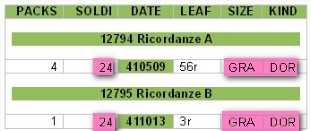 Source: Silk dealer acquire lists Antonio di Dino, who usually made decks for 5 and occasionally decks for 9 Soldi in the 1440s and later became also Trionfi card painter, has two sales at 1441-05-09 and 1441-10-13 with totally 5 decks and 24 Soldi for each deck. The decks have the qualities "Grani" and "Dorati", but any indication, that it are Trionfi decks, is missing. But it is a year, in which Trionfi decks likely already had some interests.  Source: Silk dealer acquire lists Antonio vochate il Chico dipintore sells 1 Trionfi(?) deck for 20 Soldi (it's not totally secure, if this is a Trionfi deck), and together with this a dozen of other Trionfi decks for 9 Soldi each at 1452-11-16. This operation presents the highest number (= 13) of recorded Trionfi decks in one single activity till the 96 Trionfi cards of the Cambini document in 1462. 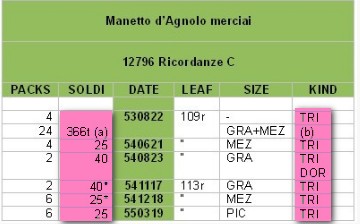 Source: Silk dealer acquire lists Manetto di Agnolo merciai sells totally 24 Trionfi decks between 1453-1455, from which at least 4 have the price of 40 Soldi (highest recorded price for Trionfi decks in the silk dealer lists) and 16 have the price of 25 Soldi (and 4 others are likely similar expensive, So one might expect, that these took also 25 or 40 Soldi or another high number, which would give a sum between 660 - 720 Soldi for expensive decks supplied by Manetto. In comparison to all other expensive decks, Piero di Antonio for Lapini family (160 Soldi), Paparello for Puri family (106 or 174 Soldi), Silk dealer Sales (33 + 25 = 58 Soldi), Simone di Ser Antonio Fazi (80 Soldi), Antonio di Dino (120 Soldi), Chico 20 Soldi), we get, that they altogether (540 - 608 Soldi) don't reach the value of the expensive decks delivered by Manetto di Agnolo (660 - 720 Soldi), so naturally he had, as far we know it, more than 50% of the observed segment of the market (expensive decks equal to 20 Soldi Soldi or more). Comparisons with FerraraIf we compare now the prices in Ferrara, we have, that in 1457 two rather expensive decks took each 8 ducats or 28 Lira Marchesana or 560 Ferrarese Soldi (before price reducement, before taxes). It's difficult to say, how much Florentine Soldi it would have been precisely at this time in Florence, but it would have been about 746 in 1447 and about 808 in 1461, so for 1457 one may estimate c. 780 Florentine Soldi. As 2 decks for this price were made in Ferrara, so we have in this bill alone a sum of c. 1560 Soldi, and this money would have bought all the expensive decks listed above and some more.The only production in Florence (the few, about we know of), which might have been in a similar category as the expensive decks in Ferrara, are those from Filippo di Marco, which he made for the art trader Bartholomeo Serragli. I didn't include them, as the presentation in the document has a lot of open questions. As a summary one can say, that Filippo di Marco got from his trade with Bartolomeo about 45 Florentine ducats, but some of this money seems to have gone to Giovanni di Domenico (maybe 5 ducats). If we assume 40 ducats, then this might have meant 3800-3900 Florentine Soldi, so far ahead of all other known expensive Florentine card productions. If we count through all known productions of Jacopo Sagramoro, we reach (with insecurities cause some document complications) roughly in long years around 50% of Filippo di Marco's total prices, and Gherardo da Vicenza similar roughly (cause further insecurities) 100% in comparable years to Filippo di Marco's "working time" (and the biggest part of the costs went just to the 2 mentioned decks in July 1457). Generally one has to see, that a big part of the high price for a "really very expensive" deck went into the worthwhile material, that was used: Gold and expensive colors, money, which wasn't earned by the artist, but was part of his production costs. |
|
|
Repeated Note: When Ross Caldwell and me in 2003 started to collect Trionfi notes between 1442-1463, we had about 27/28 entries (which I nowadays would count as 31). The major part were the documents of Ferrara, which were collected by Gherardo Ortalli and Adriano Franceschini in the "Prince and the Playing Cards" (1996), after the base laying works of Michael Dummett and Stuart Kaplan around 1980. This collection included 2 notes about Trionfi cards in Florence, found by Franco Pratesi in his earlier work (allowances of the Trionfi game in 1450 and 1463). A graphical representation of this time (with 27 entries) shows the dominance of Ferrarese documents (in black) with a few notes only from other locations (in red; see picture to the right) In the period 2004 till October 2011 it was possible to add 4 further notes (Siena 1452, Padova 1455, Ancona c. 1460 and Valerio Marcello c. 1460), mainly thanks to information given by Thierry Depaulis. Franco Pratesi started his new article series in November 2011. Since then the list has gotten 67 new documents till September 2012 (65 of them found by Franco Pratesi, one, now the oldest of September 1440, by Thierry Depaulis, and another one by Veber Gulinelli, who controlled the earlier work of Franceschini and found an overlooked document) and nearly all are related to Florence or its surrounding. A small book (118 pages) was published around Christmas 2012, Franco Pratesi: "Playing Card Trade in 15th Century Florence" as IPCS Paper No. 7 (ISSN 0305-2133). It contains some of the articles, which before had appeared at this website, those, which treat the early time of 15th century. Thierry Depaulis commented in his foreword: "This book is a landmark in the history of early playing cards in Italy". Well, maybe not the book, but the research is clearly a landmark in various interests. For the collection of early Trionfi notes it somehow means, that we have within the year 2012 about 200 % more data for the period 1440-1462 than mankind had collected in the 200 years before. Added later: In August 2013 the new report of Arnold und Doris Esch: "Aus der Frühgeschichte der Spielkarte. Der Import von carte da giocare und trionfi nach Rom." in Gutenberg Jahrbuch 2013, 88. Jahrgang, p. 41-53, arrived in our redaction. It contains 106 new references to Trionfi decks, which all were found in the customs registers of the city Rome for the period 1453-1465. With this the number of all earlier Trionfi cards records has been doubled and should have reached then c. 210 (from which a few are only considered to be "Trionfi card notes" and don't contain the word "Trionfi" or something similar). *********** I'd started to sort the new Trionfi card documents overview in October 2012. Articles will be possibly changed according improvements in research. |
|

